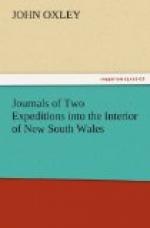October 15.—A party was sent back early this morning to secure the canoe, while we examined the river. The people returned in the course of the forenoon unsuccessful, as the natives had removed it with all their effects in the course of the night, throwing down and destroying their guniahs or bark huts. We also found that about a mile higher up the river, a branch from it joined that which we last crossed about two miles back, making an island of the ground we were upon. The main branch continued to run to the north-north-west, and north-west. We therefore lost no time in returning part of the way to the entrance into the haven, (which we named after Lord Camden), where we proposed to construct a canoe. The natives seem very numerous, but are shy: we saw many large canoes on the lake, one of which would be quite sufficient for our purposes.
October 18.—On Friday we returned to the entrance of the haven, and immediately commenced our endeavours to construct a canoe: our first essays were unsuccessful, but by Saturday night we had a bark one completed, which we hoped would answer our purpose; though I think if the natives saw it they would ridicule our rude attempts. This morning, the ebb tide answering, we commenced transporting our luggage, and in three hours every thing was safe over. A very serious misfortune however occurred in swimming the horses across: two of them were seized with the cramp near the middle of the channel, one with difficulty gained the shore, the other sank instantly and was seen no more; he was one of our best and strongest horses, and even now their weak state can ill afford a diminution in their number. This haven appears to have a perfectly safe entrance for boats and small craft at all times of tide, except at dead low water with a strong surge from the eastward, when it slightly breaks, but is still quite safe for boats if not for larger vessels. When we were in it, there appeared a safe and deep channel through the sand shoals which




